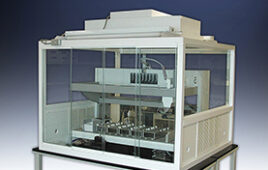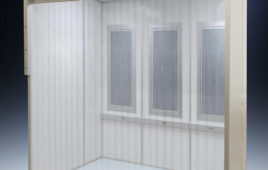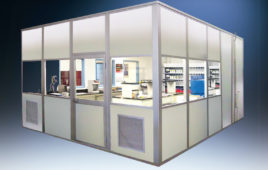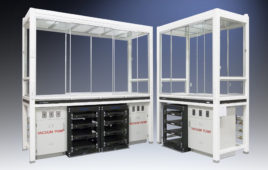When Acree Technologies began conducting research using rubidium, they were faced with workspace challenges requiring isolation. Rubidium is an element that reacts violently with water and bursts into flames spontaneously in air. The company needed an isolation system to maintain reliable inert conditions while minimizing safety risks. Frequently, research laboratories use such handling in containment systems that maintain clean, aseptic, or anaerobic processing conditions. An argon atmosphere containment system was selected in this case, for truly inert conditions to protect specimens and the experimental process.
According to associate scientist Tanya Kavka, the research supported development of a new Physical Vapor Deposition (PVD) coating to increase the durability and performance of high-energy Diode Pumped Alkali Laser Systems (DPALS) lasers. This new class of laser combines features of both gas and solid-state lasers, based on diode excitation of atomic alkali vapors — a combination of alkali elements (including rubidium), rare gases, and selected molecular gases. In addition to the potential danger in handling rubidium, the alkali element is so aggressive when heated that it also attacks the optical components within the laser itself.
“The goal of our research is to discover a coating that will protect the optical components from the rubidium, without affecting the transference of the lasing light,” explains Kavka.
To conduct these tests, Acree Technologies set out to acquire an isolation chamber workstation to support access to specimens enclosed in a special atmosphere. Acree planned to retain this isolation equipment to support other experiments requiring a controlled atmosphere or use of reactive or toxic chemicals. However, given the broad range of options available, selecting the appropriate isolation equipment can present challenges.
For many, the initial impulse is to seek out equipment similar to enclosures they are familiar with, or encountered, in other labs. Namely, heavy glove boxes with vast chambers and sophisticated control systems that can be used for practically any type of experimental process. By coincidence, a previous scientist who conducted research at the site left such a unit behind, which now sits unused.
Although the allure of such systems is understandable for labs that work on a smaller scale, have limited equipment requirements, and need a workable and failsafe device, a heavy, highly instrumented glove box is overkill as it brings additional challenges and risks. For this type of lab, the task of selecting the proper equipment becomes an exercise in “right-sizing” the equipment to meet the lab’s needs and experiments.
Right-sizing, in this context, can be defined as the process of identifying and selecting isolation equipment that is the optimum size, equipped with the required space, functions, and features, without extra capabilities not needed to do the work. For many researchers, the decision involves careful consideration of the parameters of the experiment(s) to be conducted and the ability of the isolation device to meet those specific needs. While flexibility is important, excess size and complexity often add too much risk and operational workload.
Right-sizing also involves a careful balance of the amount of space (access) required to make changes or take samples and the type of equipment that is mission critical. It also considers other important factors such as the amount of space the unit will occupy; the time required to specify, order, and install the equipment; the complexity of operation, cleaning, and adjustment demands; and the risk of downtime, as well as impact on the project schedule and budget.
By doing so, researchers achieve more reliable, accurate results, as well as fail-safe protection of specimens and laboratory staff — while reducing risk and avoiding delays, wasted effort, and additional costs.

Acree Technologies set out to acquire an isolation chamber workstation to support access to specimens enclosed in a special atmosphere. Here, associate Scientist Tanya Kavka uses the Posi-Dome. Image: Banthrax
Is bigger better?
For experiments that require isolation, an example conceptualizing the importance of selecting the right size of equipment is illustrated by a thought experiment that considers experimental testing conducted using isolation in a nuclear submarine. The purpose of a thought experiment is to consider a hypothesis or theory, such as the groundwork for Albert Einstein’s theory of special relativity. They can also be used to challenge the prevailing status quo or to identify flaws in an argument.
In this example, a modern nuclear submarine serves as the “isolation chamber” providing massive and thorough isolation from the environment surrounding it. In the event that a researcher could conduct experiments inside the submarine, the heavy steel walls and robust atmosphere controls would provide isolation and long term control far beyond the capabilities of enclosures and chambers in 99 percent of laboratories worldwide. In addition, the size, utility support, and self-contained nature of the chamber provide far more flexibility to include specimens, instruments, and equipment of any size and generous staffing to allow nearly any possible experimental process without outside influence.
While this might seem like an ideal isolation chamber free from potential contamination, the sheer size, complexity, and operational workload would be well beyond project schedule, staffing, and budgetary limits for nearly any real-world research experiment. The reasons are as simple, as the work chamber is complex:
• Too great a volume of atmosphere to control, purge, and decontaminate
• Too much inner surface area to clean and sterilize
• Too many complex nooks, crannies, light fixtures, seams, seals and electrical panels to harbor contaminants, stray molecules and microbes
• Too much complex support equipment requiring more operational effort and introducing more risk and variability into the experiment
Practically all of these issues with experiments in a submarine are the same as issues with processes in large, heavy, complex glove boxes, which are also pressure vessels and are also overkill for most experiments.
The middle ground
Given its requirements, Acree Technologies sought out a simpler, more reliable isolation alternative. Ultimately, this led to the selection of a more compact, portable bench-top model from Banthrax Corp. called the Posi-Dome I-Box. The workstation provides the special environment, whether aseptic, clean, anaerobic or special gas atmosphere. The glove box is built with a clear, polymeric top with ports for a single pair of elastomeric gloves. Additional accessories and attachment options may be added, but injection ports for premixed or regulated gases are a standard part of the design.
Glove box isolators and containment systems offer several advantages beyond the basic ability to produce reliable research results. These compact glove boxes are typically less complicated to install, use and maintain. Setup and training requires minutes, rather than weeks. The units are light and portable so they can be quickly and easily moved from one work area to another or to distant field locations.
Workstations with transparent rounded domes can also be much easier to clean and maintain than units with corners, ridges, and light fixtures inside. Purging systems are less automated, but simpler, more energy efficient, and safer than typical high-vacuum purge units.
“What is nice about the Posi-Dome is it is extremely versatile,” says Kavka. “If you have various smaller projects you do not need a big ‘beast’ of a machine. You can take the unit and put it anywhere in the lab, or use it in the field. For the type of research we do, it is the right fit.”
Additional isolator options
For some applications, right-sizing may even lead to the conclusion that a smaller bench-top model may also be more than what is required.
At the lower end are options like glove bags. Glove bags are disposable containment devices of simple design that can be effective for simple process applications. Composed of inflatable plastic (e.g. PVC or PE) with built-in gloves, this approach can meet basic isolation needs if the lack of solid walls and pressure control are permissible. Compared to hard-walled workstations glove bags are generally much easier to purge, disposable, and less expensive; disadvantages include instability, cleaning challenges, and reduced visibility, as well as control issues.
Right-size or die
Regardless of the final choice in isolation and containment systems, researchers would be wise to investigate available alternatives that will accomplish the goals of the experiment without going beyond the scope of its demands or bringing in unnecessary layers of complexity.
By right-sizing the equipment, researchers may discover suitable alternatives between the simple glove bag and the theoretical submarine that will fit into their lab, schedule, and budget.
Jeff Elliott is a Torrance, Calif.-based technical writer. He has researched and written about industrial technologies and issues for the past 20 years. He can be reached by email at [email protected].




